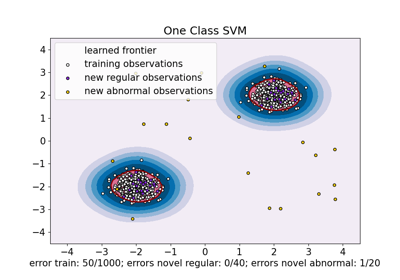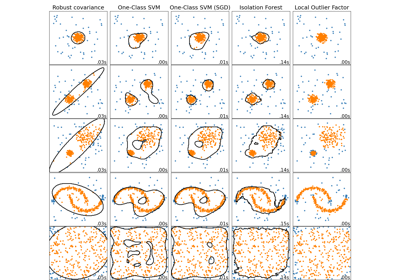sklearn.linear_model.SGDOneClassSVM¶
- class sklearn.linear_model.SGDOneClassSVM(nu=0.5, fit_intercept=True, max_iter=1000, tol=0.001, shuffle=True, verbose=0, random_state=None, learning_rate='optimal', eta0=0.0, power_t=0.5, warm_start=False, average=False)[source]¶
Solves linear One-Class SVM using Stochastic Gradient Descent.
This implementation is meant to be used with a kernel approximation technique (e.g.
sklearn.kernel_approximation.Nystroem) to obtain results similar tosklearn.svm.OneClassSVMwhich uses a Gaussian kernel by default.Read more in the User Guide.
New in version 1.0.
- Parameters
- nufloat, default=0.5
The nu parameter of the One Class SVM: an upper bound on the fraction of training errors and a lower bound of the fraction of support vectors. Should be in the interval (0, 1]. By default 0.5 will be taken.
- fit_interceptbool, default=True
Whether the intercept should be estimated or not. Defaults to True.
- max_iterint, default=1000
The maximum number of passes over the training data (aka epochs). It only impacts the behavior in the
fitmethod, and not thepartial_fit. Defaults to 1000.- tolfloat or None, default=1e-3
The stopping criterion. If it is not None, the iterations will stop when (loss > previous_loss - tol). Defaults to 1e-3.
- shufflebool, default=True
Whether or not the training data should be shuffled after each epoch. Defaults to True.
- verboseint, default=0
The verbosity level.
- random_stateint, RandomState instance or None, default=None
The seed of the pseudo random number generator to use when shuffling the data. If int, random_state is the seed used by the random number generator; If RandomState instance, random_state is the random number generator; If None, the random number generator is the RandomState instance used by
np.random.- learning_rate{‘constant’, ‘optimal’, ‘invscaling’, ‘adaptive’}, default=’optimal’
The learning rate schedule to use with
fit. (If usingpartial_fit, learning rate must be controlled directly).‘constant’:
eta = eta0‘optimal’:
eta = 1.0 / (alpha * (t + t0))where t0 is chosen by a heuristic proposed by Leon Bottou.‘invscaling’:
eta = eta0 / pow(t, power_t)‘adaptive’: eta = eta0, as long as the training keeps decreasing. Each time n_iter_no_change consecutive epochs fail to decrease the training loss by tol or fail to increase validation score by tol if early_stopping is True, the current learning rate is divided by 5.
- eta0float, default=0.0
The initial learning rate for the ‘constant’, ‘invscaling’ or ‘adaptive’ schedules. The default value is 0.0 as eta0 is not used by the default schedule ‘optimal’.
- power_tfloat, default=0.5
The exponent for inverse scaling learning rate [default 0.5].
- warm_startbool, default=False
When set to True, reuse the solution of the previous call to fit as initialization, otherwise, just erase the previous solution. See the Glossary.
Repeatedly calling fit or partial_fit when warm_start is True can result in a different solution than when calling fit a single time because of the way the data is shuffled. If a dynamic learning rate is used, the learning rate is adapted depending on the number of samples already seen. Calling
fitresets this counter, whilepartial_fitwill result in increasing the existing counter.- averagebool or int, default=False
When set to True, computes the averaged SGD weights and stores the result in the
coef_attribute. If set to an int greater than 1, averaging will begin once the total number of samples seen reaches average. Soaverage=10will begin averaging after seeing 10 samples.
- Attributes
- coef_ndarray of shape (1, n_features)
Weights assigned to the features.
- offset_ndarray of shape (1,)
Offset used to define the decision function from the raw scores. We have the relation: decision_function = score_samples - offset.
- n_iter_int
The actual number of iterations to reach the stopping criterion.
- t_int
Number of weight updates performed during training. Same as
(n_iter_ * n_samples).- loss_function_concrete
LossFunction - n_features_in_int
Number of features seen during fit.
New in version 0.24.
- feature_names_in_ndarray of shape (
n_features_in_,) Names of features seen during fit. Defined only when
Xhas feature names that are all strings.New in version 1.0.
See also
sklearn.svm.OneClassSVMUnsupervised Outlier Detection.
Notes
This estimator has a linear complexity in the number of training samples and is thus better suited than the
sklearn.svm.OneClassSVMimplementation for datasets with a large number of training samples (say > 10,000).Examples
>>> import numpy as np >>> from sklearn import linear_model >>> X = np.array([[-1, -1], [-2, -1], [1, 1], [2, 1]]) >>> clf = linear_model.SGDOneClassSVM(random_state=42) >>> clf.fit(X) SGDOneClassSVM(random_state=42)
>>> print(clf.predict([[4, 4]])) [1]
Methods
Signed distance to the separating hyperplane.
densify()Convert coefficient matrix to dense array format.
fit(X[, y, coef_init, offset_init, ...])Fit linear One-Class SVM with Stochastic Gradient Descent.
fit_predict(X[, y])Perform fit on X and returns labels for X.
get_params([deep])Get parameters for this estimator.
partial_fit(X[, y, sample_weight])Fit linear One-Class SVM with Stochastic Gradient Descent.
predict(X)Return labels (1 inlier, -1 outlier) of the samples.
Raw scoring function of the samples.
set_params(**params)Set the parameters of this estimator.
sparsify()Convert coefficient matrix to sparse format.
- decision_function(X)[source]¶
Signed distance to the separating hyperplane.
Signed distance is positive for an inlier and negative for an outlier.
- Parameters
- X{array-like, sparse matrix}, shape (n_samples, n_features)
Testing data.
- Returns
- decarray-like, shape (n_samples,)
Decision function values of the samples.
- densify()[source]¶
Convert coefficient matrix to dense array format.
Converts the
coef_member (back) to a numpy.ndarray. This is the default format ofcoef_and is required for fitting, so calling this method is only required on models that have previously been sparsified; otherwise, it is a no-op.- Returns
- self
Fitted estimator.
- fit(X, y=None, coef_init=None, offset_init=None, sample_weight=None)[source]¶
Fit linear One-Class SVM with Stochastic Gradient Descent.
This solves an equivalent optimization problem of the One-Class SVM primal optimization problem and returns a weight vector w and an offset rho such that the decision function is given by <w, x> - rho.
- Parameters
- X{array-like, sparse matrix}, shape (n_samples, n_features)
Training data.
- yIgnored
Not used, present for API consistency by convention.
- coef_initarray, shape (n_classes, n_features)
The initial coefficients to warm-start the optimization.
- offset_initarray, shape (n_classes,)
The initial offset to warm-start the optimization.
- sample_weightarray-like, shape (n_samples,), optional
Weights applied to individual samples. If not provided, uniform weights are assumed. These weights will be multiplied with class_weight (passed through the constructor) if class_weight is specified.
- Returns
- selfobject
Returns a fitted instance of self.
- fit_predict(X, y=None)[source]¶
Perform fit on X and returns labels for X.
Returns -1 for outliers and 1 for inliers.
- Parameters
- X{array-like, sparse matrix} of shape (n_samples, n_features)
The input samples.
- yIgnored
Not used, present for API consistency by convention.
- Returns
- yndarray of shape (n_samples,)
1 for inliers, -1 for outliers.
- get_params(deep=True)[source]¶
Get parameters for this estimator.
- Parameters
- deepbool, default=True
If True, will return the parameters for this estimator and contained subobjects that are estimators.
- Returns
- paramsdict
Parameter names mapped to their values.
- partial_fit(X, y=None, sample_weight=None)[source]¶
Fit linear One-Class SVM with Stochastic Gradient Descent.
- Parameters
- X{array-like, sparse matrix}, shape (n_samples, n_features)
Subset of the training data.
- yIgnored
Not used, present for API consistency by convention.
- sample_weightarray-like, shape (n_samples,), optional
Weights applied to individual samples. If not provided, uniform weights are assumed.
- Returns
- selfobject
Returns a fitted instance of self.
- predict(X)[source]¶
Return labels (1 inlier, -1 outlier) of the samples.
- Parameters
- X{array-like, sparse matrix}, shape (n_samples, n_features)
Testing data.
- Returns
- yarray, shape (n_samples,)
Labels of the samples.
- score_samples(X)[source]¶
Raw scoring function of the samples.
- Parameters
- X{array-like, sparse matrix}, shape (n_samples, n_features)
Testing data.
- Returns
- score_samplesarray-like, shape (n_samples,)
Unshiffted scoring function values of the samples.
- set_params(**params)[source]¶
Set the parameters of this estimator.
The method works on simple estimators as well as on nested objects (such as
Pipeline). The latter have parameters of the form<component>__<parameter>so that it’s possible to update each component of a nested object.- Parameters
- **paramsdict
Estimator parameters.
- Returns
- selfestimator instance
Estimator instance.
- sparsify()[source]¶
Convert coefficient matrix to sparse format.
Converts the
coef_member to a scipy.sparse matrix, which for L1-regularized models can be much more memory- and storage-efficient than the usual numpy.ndarray representation.The
intercept_member is not converted.- Returns
- self
Fitted estimator.
Notes
For non-sparse models, i.e. when there are not many zeros in
coef_, this may actually increase memory usage, so use this method with care. A rule of thumb is that the number of zero elements, which can be computed with(coef_ == 0).sum(), must be more than 50% for this to provide significant benefits.After calling this method, further fitting with the partial_fit method (if any) will not work until you call densify.


